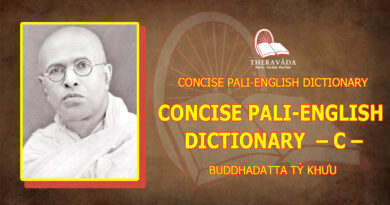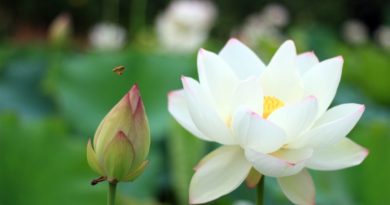Pāli Primer – Lesson 11
Lesson 11
VOCABULARY
1. Neuter nouns ending in -a
| āpaṇa | shop, bazaar |
| puñña | merit |
| pāpa | evil, sin |
| kamma | deed, action |
| kusala | good |
| akusala | evil |
| dhana | wealth |
| dhañña | corn |
| bīja | seed |
| dussa | cloth |
| cīvara | robe |
| mūla | root, money |
| rukkhamūla | foot of a tree |
| tuṇḍa | beak |
| vetana | wage, pay |
| paduma | lotus |
| gīta | song |
| suvaṇṇa / hirañña | gold |
| sacca | truth |
| pānīya | drinking water |
| citta | mind |
Verbs
| pariyesati | searches, seeks |
| ārabhati | begins |
| ussahati | tries |
| upasaṅkamati | approaches |
| adhigacchati | understands, attains |
| gāyati | sings |
| āmasati | touches, strokes |
| bhāyati | fears |
| cavati | departs, dies |
| uppajjati | is born |
| khipati | throws |
| vapati | sows |
| ākaṅkhati | hopes |
| sibbati | sews |
2. The Present Participle
Present participles are formed by adding -nta / māna to the verbal base.
They function as adjectives and agree in gender, number and case with the nouns they qualify.
They are declined like -a ending nouns in the masculine and neuter.
(As the feminine gender has not been introduced thus far, the feminine gender of the present participle is explained in Lesson 21).
| paca + nta / māna = | pacanta / pacamāna = | cooking |
| gaccha + nta / māna = | gacchanta / gacchamāna = | going |
| bhuñja + nta / māna = | bhuñjanta / bhuñjamāna = | eating |
| tiṭṭha + nta / māna = | tiṭṭhanta / tiṭṭhamāna = | standing |
| vihara + nta / māna = | viharanta / viharamāna = | dwelling |
3. Examples in sentence formation
Singular:
1. Bhattaṃ pacanto / pacamāno puriso hasati. (Nom. case)
The man who is cooking rice laughs.
2. Vejjo bhattaṃ pacantaṃ / pacamānaṃ purisaṃ pakkosati. (Acc. case)
The doctor calls the man who is cooking rice.
3. Vejjo bhattaṃ pacantena / pacamānena purisena saha bhāsati. (Inst.case)
The doctor speaks with the man who is cooking rice.
Plural:
1. Bhattaṃ pacantā / pacamānā purisā hasanti. (Nom. case)
The men who are cooking rice laugh.
2. Vejjo bhattaṃ pacante / pacamāne purise pakkosati. (Acc. case)
The doctor calls the men who are cooking rice.
3. Vejjo bhattaṃ pacantehi / pacamānehi purisehi saha bhāsati. (Inst.case)
The doctor speaks with the men who are cooking rice.
Similarly, the present participle can be declined in all cases to agree with the nouns they qualify.
Exercise 11:
4. Translate into English:
1. Pānīyaṃ yācitvā rodanto dārako mañcamhā patati.
2. Vatthāni labhituṃ icchanto vāṇijo āpaṇaṃ gacchati.
3. Upāsako padumāni ādāya vihāraṃ gacchamāno Buddhaṃ disvā pasīdati.
4. Sakuṇo tuṇḍena phalaṃ haranto rukkhasmā uppatati.
5. Cīvaraṃ pariyesantassa samaṇassa ācariyo cīvaraṃ dadāti.
6. Araññe āhiṇḍanto luddako dhāvantaṃ migaṃ passitvā sarena vijjhati.
7. Uyyāne āhiṇḍamānamhā kumāramhā brāhmaṇo padumāni yācati.
8. Rathena gacchamānehi amaccehi saha ācariyo hasati.
9. Dānaṃ dadāmānā sīlāni rakkhamānā manussā sagge uppajjanti.
10. Dhaññaṃ ākaṅkhantassa purisassa dhanaṃ dātuṃ vāṇijo icchati.
11. Goṇe hanantā rukkhe chindantā asappurisā dhanaṃ saṃharituṃ ussahanti.
12. Vihāraṃ upasaṅkamanto Buddho dhammaṃ bhāsamāne sāvake passati.
13. Rukkhamūle nisīditvā gītāni gāyantā kumārā naccituṃ ārabhanti.
14. Suvaṇṇaṃ labhituṃ ussahantā manussā pabbatasmiṃ āvāṭe khaṇanti.
15. Udakaṃ pātuṃ icchanto sīho udakaṃ pariyesamāno vanamhi carati.
16. Vetanaṃ labhituṃ ākaṅkhamāno naro rajakāya dussāni dhovati.
17. Samaṇehi bhāsantā upāsakā saccaṃ adhigantuṃ ussahanti.
18. Magge sayantaṃ sunakhaṃ udakena siñcitvā dārako hasati.
19. Sīlaṃ rakkhantā sappurisā manussalokā cavitvā devaloke uppajjanti.
20. Dhanaṃ saṃharituṃ ussahanto vāṇijo samuddaṃ taritvā dīpaṃ gantuṃ ārabhati.
21. Goṇe pariyesamāno vane āhiṇḍanto kassako sīhaṃ disvā bhāyati.
22. Rukkhesu nisīditvā phalāni bhuñjamānā kumārā gītaṃ gāyanti.
23. Cittaṃ pasīditvā dhammaṃ adhigantuṃ ussahantā narā sagge uppajjanti.
24. Tuṇḍena piṭakamhā macchaṃ ākaḍḍhituṃ icchanto kāko sunakhamhā bhāyati.
25. Khettaṃ kasitvā bījāni vapanto kassako dhaññaṃ labhituṃ ākaṅkhati.
26. Suriyassa ālokena locanehi rūpāni passantā manussā loke jīvanti.
27. Rukkhamūle nisīditvā cīvaraṃ sibbantena samaṇena saddhiṃ upāsako bhāsati.
28. Rukkhamūle sayantassa yācakassa kāye paṇṇāni patanti.
29. Vāṇijassa mūlaṃ datvā asse labhituṃ amacco ussahati.
30. Khīraṃ pivitvā hasamāno dārako pattaṃ mañcasmiṃ khipati.
5. Translate into Pāli.
1. The man washing clothes speaks with the boy going on the road.
2. The brahmin sees the deer coming out of the forest to drink water.
3. Goats in the park eat leaves falling from the trees.
4. Wicked men wish to see hunters killing deer.
5. The farmer sees birds eating seeds in his field.
6. Recluses who enter the city wish to worship the Buddha dwelling in the monastery.
7. Standing on the stairway the child sees monkeys sitting on the tree.
8. Boys give rice to fish moving in the water.
9. The sailor wishing to cross the sea asks for money from the king.
10. Men see with their eyes the light of the moon falling on the sea.
11. Lay devotees try to give robes to monks living in the monastery.
12. Wishing for merit virtuous men give alms to the monks and observe (rakkhanti) the precepts.
13. The man walks on the leaves falling from the trees in the forest.
14. The uncle gives a lotus to the child searching for flowers.
15. Having given the beggar some corn the fisherman enters the house.
16. The minister gives seeds to the farmers who plough their fields.
17. The dog tries to bite the hand of the man who strokes his body.
18. The Buddha’s disciples question the child crying on the road.
19. The uncle’s friend calls the boys singing songs seated under the tree.
20. Virtuous men give food to the monks who approach their houses.
21. Wise men who wish to be born in heaven practise (rakkhanti) virtue.
22. Seeing the jackal approaching the village the farmer tries to hit it with a stone.
23. Speaking the truth lay devotees try to understand the doctrine.
24. Having washed the bowl with water the hermit looks for drinking water.
25. Wise men who observe the precepts begin to understand the truth.
-ooOoo-









